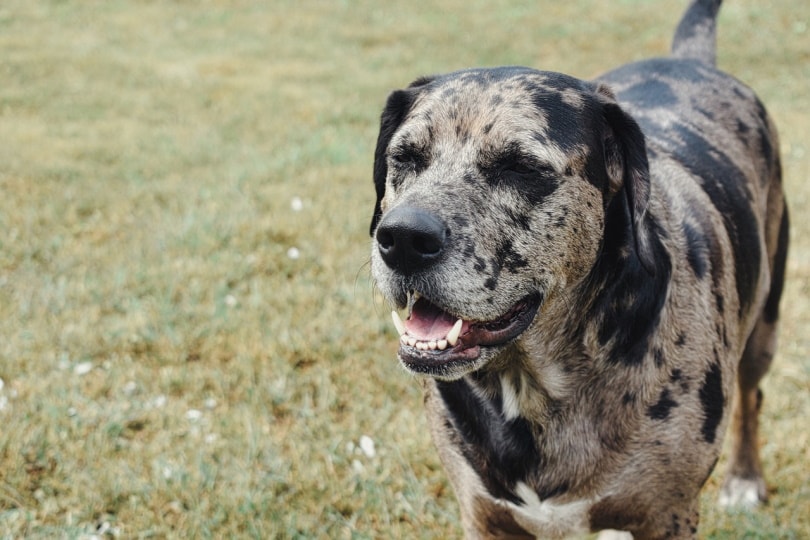What Breeds of Dogs Are Prone to Deafness? Vet Reviewed Guide & FAQ
By Brooke Bundy
Updated on

Deafness in dogs can be inherited or acquired. Acquired hearing loss can be caused by many different factors including ear infections, some medications and old age. Most puppies that are born deaf (congenital deafness) have an inherited disorder and although any breed can be affected, some dog breeds have more recorded cases than others. There is a strong link between congenital deafness and a white coat color and merle coat pattern.
Why Are Some Dogs More Susceptible to Deafness?
Congenital deafness is caused by gene defects. The presence of white in the hair coat and blue eyes increases the chances of deafness.1 The pigmentation gene for merle coats and piebald coats are in particular associated with deafness in dogs.2 Merle coats are irregular blotches of fur on a lighter background of the same pigment for example solid black on gray. Piebald is more of a spotty coat pattern. It should be noted that not all white dogs will be deaf, nor are all deaf dogs white. Also, not all breeds that are prone to deafness will be deaf. Many breeders of dogs that have hereditary deafness will choose to BAER ( Brainstem Auditory Evoked Response) test their breeding dogs and puppies to reduce the risks.

The 8 Dog Breeds Prone to Deafness
There are approximately 80 different breeds with records of congenital deafness, but here are some breeds with higher-than-normal rates of congenital deafness:
1. Dalmatian

As a white spotted breed, the Dalmatian has the highest number of cases of congenital deafness. It’s estimated that 30% of the Dalmatian population is born with at least some deafness affecting one or both ears.3 Researchers have shown that there are a number of genes and other factors interacting and influencing a dog’s hearing loss.
2. Australian Cattle Dog

Australian Cattle Dogs are also prone to deafness.One study has indicated that female Australian Cattle Dogs are more likely to be deaf than the males are and that there is a link to certain coat patterns.4
3. Bull Terrier

Another breed with a predominately white coat is the Bull Terrier, and about 18% of Bull Terriers are born with at least some hearing problems1. Bull Terriers can be deaf in one or both ears. Many breeders of Bull Terriers perform a BAER (Brainstem Auditory Evoked Response) test on the puppies when they are around 5 weeks old, which can help determine the severity of the deafness.
4. Catahoula

The Catahoula Leopard Dog originated in Louisiana and is well known for its unique coat coloring and merle patterned coat. However, since the merle gene is linked to deafness, it should come as no surprise that this breed is prone to deafness. Catahoulas with a white coat or face can have an 80% chance of being deaf in at least one ear.
5. Double Dapple Dachshund

Double Dapple Dachshunds are the result of breeding two Dapple Dachshunds together. This is thought to be a combination which can lead to deafness, blindness, and even ‘micro’ or missing eyes. In fact, many breeders won’t even breed two Dapple Dachshunds together because of the detrimental health problems it can cause. Note that Dachshunds that have other coats other than dappled don’t seem to be affected as much by congenital deafness.
6. English Cocker Spaniel

English Cocker Spaniels can also be prone to deafness, particularly if they have a parti-colored coat. Cocker Spaniel puppies with this coat color are more predisposed to becoming completely deaf by 4 weeks old. Many breeders use the BAER test with English Cocker Spaniels to test for deafness. Cocker Spaniels are also a breed that is prone to ear problems and deafness as they age.
7. English Setter

English Setters are another breed that tend to have a merle coat coloring, and as a result, the breed is often prone to congenital deafness. A study found that 3.6 percent of 447 English Setter puppies were deaf in one ear, 0.9 percent were deaf in both ears and that females were 3.3 times more likely to be deaf than males.
8. Jack Russell Terrier

Many Jack Russell Terriers have a predominately white coat, which is associated with deafness. A study found that out of 1,009 Jack Russell Terriers, 3.57% of them were deaf in at least one ear. Interestingly, the study couldn’t find a link between sex and deafness in these dogs, so the deafness link is solely based on having a white coat and the status of hearing in the dog’s parents.
Top 4 Reasons Dogs Become Deaf
Although a rare number of dogs are born deaf, any dog may experience hearing loss over time even if they aren’t born deaf. Here are some common reasons why dogs sometimes become deaf, or at least suffer partial hearing loss:
1. Old age
Growing older is the most common reason for acquired deafness.

2. Repeated exposure to loud noises
Injuries or repeated exposure to loud noises can put your dog at an increased risk of hearing loss, or make the problem worse. Keeping your dog away from super loud noises such as fireworks, guns, and lawn mowers can help protect their hearing for the years to come. in hearing loss.
3. Otitis Externa
Deep ear infections can damage or rupture the eardrum causing internal ear infections and affecting hearing.

4. Blockages
Wax buildup, things stuck in the ears like grass seeds and tumors of the ear canal can all affect hearing.
How to Tell If Your Dog Is Deaf
It can be hard to tell if your dog is partially deaf, but it’s relatively easy to note if they can’t hear at all. Your dog may be deaf or hard of hearing if they:
- Act unreasonably aggressive or fearful when playing with other dogs
- Remain unresponsive when you call their name
- Don’t react to loud noises
- Bark unusually
If you suspect that your dog may be deaf, you can take them to the vet to confirm with a diagnostic test. The BAER test is usually a specialist test and the most effective one. The test checks if the brain responds to noise, usually clicking sounds, by attaching small electrodes under the skin and soft foam inserts into the ear canal.
Conclusion
Although some breeds are more predisposed to deafness than others, congenital deafness is usually linked to white or merle coats. Dalmatians have the highest rate of congenital deafness of any breed, with an estimated 30% of the Dalmatian population born without being able to hear in at least one ear.
Canines of any breed may also develop acquired deafness as a result of injury, infection, or simply getting older. Avoiding repeated exposure to loud noises and keeping their ears clean are two of the best ways you can protect your dog’s hearing, which lowers their risk of preventable acquired deafness.
- You may also be interested in: Are There Hearing Aids for Dogs? Vet Approved Facts & FAQs
Featured Image Credit to: Zivica Kerkez, Shutterstock












